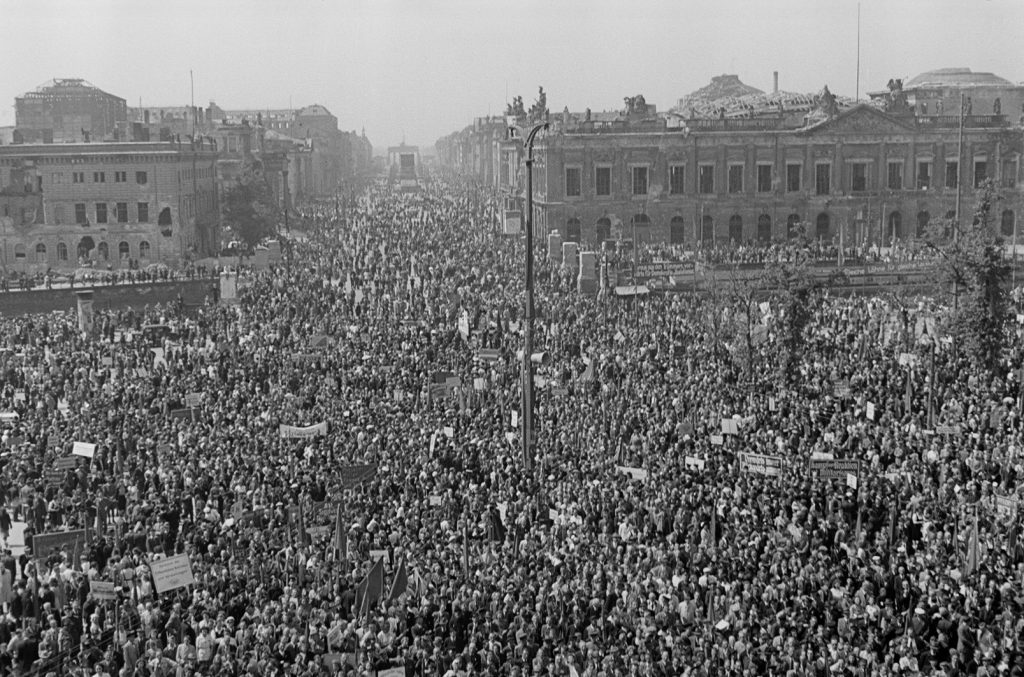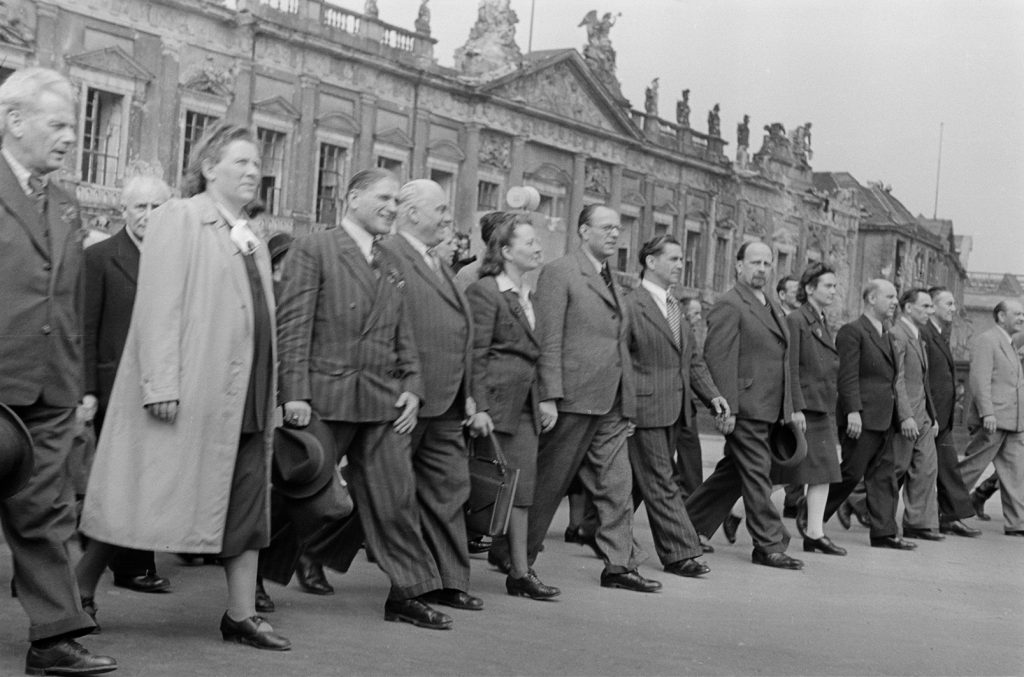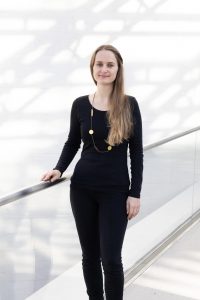
Marching under Red Flags
The Berlin Zeughaus as the scene of a political stage act on 1 May 1946
Lisa Sophie Gebhard | 28 April 2023
More than 500,000 people participated in the first May Day demonstration of the post-war period in Berlin, according to a positive assessment in Neues Deutschland, the central organ of the SED. On 3 May 1946, the newspaper reported that workers from all districts of the city came together to march in columns to the Berlin Lustgarten (pleasure garden). The photographer Abraham Pisarek documented this impressive unitary demonstration, which as such was a highly political event. Our trainee Lisa Sophie Gebhard talks about the background of Pisarek’s photo of the demonstration, at the head of which marched the first party executive of the Socialist Unity Party of Germany (SED).
May Day 1946 was to be a festive occasion in Berlin. After the Allied Control Council had confirmed the 1st of May as a holiday and given a conditional clearance for May Day demonstrations, hundreds of thousands of Berliners came to the city centre on this Wednesday.[1] In 20° C. spring weather, the official May Day rally began at noon in the Lustgarten. Thousands of people now gathered at the demonstration grounds on the River Spree, where 14 years earlier crowds had demonstrated for socialist values under red flags for the last time before the Nazi regime declared May Day 1933 the “Day of National Labour” and abused it for their own propaganda. Now that the war was over, the people were treated to a variety of sports events with folk dances and acrobatic performances on roller skates and gyro-wheels. Culinary delights, too, were provided: 100,000 sausages were made available to the participants of the May rally, which could be exchanged for food coupons at the sausage stalls of the so-called “Wurstmaxen”,[2] who were known for their Berliner earthiness. At the same time, whole cases of milk and beer were delivered and a mobile post office with a special postmark was set up at the grounds.

In this way, a folk festival-like assemblage of the urban working class came together – a year earlier it would have been unthinkable. Until 2 May 1945, bitter fighting had raged in the Battle of Berlin: power cuts darkened the capital of the Reich, corpses littered the streets, frightened people pushed their way into cellars. A year later, life in the metropolis, whose centre lay largely in ruins, gradually became normal. “The Berliners,” reported an observer in Neues Deutschland, “are laughing again, truly and deeply like a person who believes and hopes. […] They don’t plunge into a bomb crater, no siren rips open their well-deserved night rest, and nowhere does an aerial mine pluck the roof off of one’s head.”[3]
The people longed for a normal everyday existence and displayed it in their clothes. Many of the participants in the May Day festivities put on their finest clothing that had survived the war.

To be sure, May Day 1946 was not conceived as a superficial, unpolitical celebration. Instead, it carried on the tradition of May Day parades, where “hand and head workers”[4] had demonstrated for freedom, peace and justice worldwide since 1890. In the eyes of the only recently founded Socialist Unity Party of Germany (SED), the 1946 International Labour Day of the working class should celebrate the rebirth of Berlin under the banner of the united workforce. The unification of the two labour parties KPD and SPD as well as the merger of individual trade unions into the Free German Trade Union Federation (FDGB) were to guide the united working class demonstratively through the capital city. This was to make the SED’s claim to power visible to all. And it was therefore the first central executive body of the party that self-assertively marched at the head of the column, as it made its way from the Brandenburg Gate to the rally in the Lustgarten.
When the leading SED politicians marched passed the Berlin Zeughaus, the photographer Abraham Pisarek grabbed his camera. Pisarek, who had been born near Łódź in 1901 and had experienced the Second World War as one of only around 1,700 Jews who had survived in hiding in Berlin, was there at the demonstration. At this time he was documenting the political upheavals in the Soviet Occupation Zone and working as a press photographer; his pictures were later published in Neues Deutschland.[5] His photo series of the historic handshake of the communist Wilhelm Pieck and the social democrat Otto Grotewohl on 21 April 1946 in the Berlin Admiralspalast are among Pisarek’s best known works. The handshake that sealed the merger of the two parties into the SED, shown in stylised form before the backdrop of the red flag of the labour movement, functioned for decades as the party emblem of the SED.[6]

The black-and-white photo shows the party executive on the castle bridge with the eastern wing of the Zeughaus in the background, which, like many other buildings in the city centre, shows signs of the war damage. It illustrates, so to speak, the SED’s publicly staged claim to power. United in a row, the leading men and women of the party – they, too, in festive clothing – lead the way into the future with head held high and vigorous step. Alongside Pieck and Grotewohl are Walter Ulbricht and Hermann Matern, who later hold important positions in the GDR. As chairman of the State and Minister Council of the GDR and of the National Defence Council, it was Walter Ulbricht who was to shape the character of the young republic.
The original photo, which is archived in the Deutsche Fotothek in Dresden and preserved as a copy in the Deutsches Historisches Museum, shows three female members of the central executive, including the social democrat Käthe Kern, then aged 45. With hat and briefcase, she walks with visible pride at the side of her party comrade Otto Grotewohl, with whom she maintained a lifelong amicable relationship. When the leading men and women of the SED and the FDGB had gathered on the platform in the Lustgarten, they held political speeches. Kern, too, was allowed to speak as “spokeswoman for the German Woman”.[7] In her address she called upon all women to contribute to their own equality of status through equitable “reconstruction work”.[8] As SED secretary for women and co-chairperson of the Democratic Women’s League of Germany (DFD), Kern was later able to exert her influence on the founding constitution. Her demand to treat women as equal in all areas of state, economy and social life was codified in Art. 7 of the GDR constitution of 1949. Unlike in the Federal Republic, from the beginning women in the GDR were granted not only the same citizenship rights, but were also guaranteed equality under civil law.[9]
The May Day celebrations of 1946 offered the newly founded SED a suitable forum to present their claim to power directly to the people. Their aim was to stage a collective identity that was to be certified dramaturgically in the ceremonial act.[10] The fact that the founding of the Marxist-Leninist party came about not only through general approval, but also under coercion and deception was not mentioned on this springtime labour day and holiday.[11] Instead, the political speeches on the idea of socialist unity and the hundreds of red banners with the new emblem of the entwined hands invoked a harmonious, united working class. Photos of this major event, which attracted the crowds with culinary delicacies and athletic entertainment programmes in a post-war period marked by deprivation, recorded the power-political claim and staged the scene for it, as we see in Pisarek’s photographs. In this way the war-damaged Berlin Zeughaus – symbol of the defeated Prussian militarism – became the photogenic backdrop for a power-political performance.
In later decades, May Day functioned as a central political holiday on which the GDR presented itself as the “better Germany”.[12] Demands for better working and living conditions were not to be voiced there, but instead the celebration focused on the ritualised and flaunted loyalty of the people towards the leadership of the state. With what extravagance this loyalty was first rehearsed in 1946 is impressively documented in Pisarek’s photos. As a Jew and survivor of the Holocaust, he set high hopes in the establishment of an anti-fascist GDR, whose political leadership, however, soon launched anti-Zionist campaigns. Pisarek later worked as a theatre photographer in the GDR and died in West Berlin in 1983.
As a woman and social democrat, Käthe Kern, the feminist SED politician once standing in the front row of the party executive, was in the course of the 1950s increasingly limited to carrying out the resolutions of the party in her ministry. Women’s issues had been placed on the back burner. Käthe Kern died in East Berlin in 1985 at an advanced age. May Day 1946, as a future-affirming “triumphal day of the idea of unity” [13] and of democratic awakening which had been optimistically spearheaded by Kern and accompanied by Pisarek’s camera in Berlin, could not yet have foreseen these developments.
[1] Neues Deutschland, which appeared nationwide as a licenced newspaper for the first time on 23 April 1946, reported extensively on 3 May 1946 about the May Day festivities in Berlin.
[2] „Letzte Berliner Neuigkeiten. ,Wurstmaxe‘ am 1. Mai“, in: Neues Deutschland. Zentralorgan der Sozialistischen Einheitspartei Deutschlands, 1 May 1946, p. 6.
[3] „Gesichter unter Fahnen. Augenblicksbilder von der großen Mai-Demonstration“, in: Ibid., 3 May 1946, p. 4.
[4] M.N., „Mai-Erkenntnisse“, in: ibid., p. 2.
[5] Joachim Schlör (ed.), Jüdisches Leben in Berlin 1933–1941. Fotografien von Abraham Pisarek, Berlin 2012, p. 29.
[6] See the corresponding LeMO object “Photo handshake Pieck – Grotewohl”, accessible online under: https://www.hdg.de/lemo/bestand/objekt/foto-haendedruck-pieck-grotewohl.html
[7] „Unter dem Banner der Arbeitereinheit“, in: Neues Deutschland. Zentralorgan der Sozialistischen Einheitspartei Deutschlands, 3 May 1946, p. 1.
[8] Ibid., p. 2.
[9] Frank Rainer Dietze, Die Verfassung der DDR. Zur verfassungsgeschichtlichen Entwicklung der Deutschen Demokratischen Republik von 1949-1990, Hamburg 2018, p. 236. On the biography and importance of Käthe Kern see Rita Pawlowski, „Katharina (Käthe) Kern“, in Renate Genth et al (eds.), Frauenpolitik und politisches Wirken von Frauen im Berlin der Nachkriegszeit 1945–1949, Berlin 1996, pp. 277-279; „Genossin Käthe Kern“ (obituary), in: Neues Deutschland. Organ des Zentralkomitees der Sozialistischen Einheitspartei Deutschlands, 17.4.1985, p. 2.
[10] Monika Gibas/Rainer Gries, „Die Inszenierung des sozialistischen Deutschland. Geschichte und Dramaturgie der Dezennienfeiern in der DDR“, in: Gibas/Gries (eds.), Wiedergeburten. Zur Geschichte der runden Jahrestage der DDR, Leipzig 1999, pp. 11-40, here p. 13.
[11] On the early history of the SED, see among others Andreas Malycha/Peter Jochen Winters, Geschichte der SED. Von der Gründung bis zur Linkspartei, Bonn 2009.
[12] The May Day celebrations under the sign of the 40th anniversary of the GDR in 1989 were starkly co-opted by the SED leadership. See „Viereinhalbstündiger Aufmarsch von über 700 000 Berlinern“, in: Neues Deutschland. Organ des Zentralkomitees der Sozialistischen Einheitspartei Deutschlands, 2 May 1989, p. 1.
[13] M.N., „Mai-Erkenntnisse“, p. 2.
|
Foto: DHM/Thomas Bruns |
Dr. Lisa Sophie GebhardDr. Lisa Sophie Gebhard is a research volunteer in the Collection Departmentst. |
